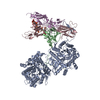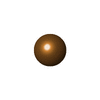+ Open data
Open data
- Basic information
Basic information
| Entry | Database: PDB / ID: 7ysh | ||||||||||||||||||||||||||||||||||||||||||||||||||||||||||||||||||||||||||||||||||||
|---|---|---|---|---|---|---|---|---|---|---|---|---|---|---|---|---|---|---|---|---|---|---|---|---|---|---|---|---|---|---|---|---|---|---|---|---|---|---|---|---|---|---|---|---|---|---|---|---|---|---|---|---|---|---|---|---|---|---|---|---|---|---|---|---|---|---|---|---|---|---|---|---|---|---|---|---|---|---|---|---|---|---|---|---|---|
| Title | Cryo-EM Structure of FGF23-FGFR1c-aKlotho-HS Quaternary Complex | ||||||||||||||||||||||||||||||||||||||||||||||||||||||||||||||||||||||||||||||||||||
 Components Components |
| ||||||||||||||||||||||||||||||||||||||||||||||||||||||||||||||||||||||||||||||||||||
 Keywords Keywords | SIGNALING PROTEIN / FGF hormones / FGF Receptor / Klotho Co-Receptor / Heparan Sulfate Glycosaminoglycans | ||||||||||||||||||||||||||||||||||||||||||||||||||||||||||||||||||||||||||||||||||||
| Function / homology |  Function and homology information Function and homology information: / type 1 fibroblast growth factor receptor binding / FGFRL1 modulation of FGFR1 signaling / norepinephrine biosynthetic process / beta-glucuronidase / regulation of phosphate transport / FGFR1c and Klotho ligand binding and activation / negative regulation of hormone secretion / positive regulation of MAPKKK cascade by fibroblast growth factor receptor signaling pathway / beta-glucuronidase activity ...: / type 1 fibroblast growth factor receptor binding / FGFRL1 modulation of FGFR1 signaling / norepinephrine biosynthetic process / beta-glucuronidase / regulation of phosphate transport / FGFR1c and Klotho ligand binding and activation / negative regulation of hormone secretion / positive regulation of MAPKKK cascade by fibroblast growth factor receptor signaling pathway / beta-glucuronidase activity / vitamin D catabolic process / response to sodium phosphate / Signaling by activated point mutants of FGFR3 / FGFR3c ligand binding and activation / negative regulation of bone mineralization / Phospholipase C-mediated cascade; FGFR3 / phosphate ion homeostasis / fibroblast growth factor receptor binding / FGFR2c ligand binding and activation / Activated point mutants of FGFR2 / Phospholipase C-mediated cascade; FGFR2 / FGFR4 ligand binding and activation / Phospholipase C-mediated cascade; FGFR4 / vitamin D binding / Signaling by activated point mutants of FGFR1 / FGFR1c ligand binding and activation / intracellular phosphate ion homeostasis / cellular response to vitamin D / energy reserve metabolic process / Downstream signaling of activated FGFR1 / Phospholipase C-mediated cascade: FGFR1 / response to angiotensin / cellular response to leptin stimulus / negative regulation of systemic arterial blood pressure / cellular response to interleukin-6 / response to vitamin D / cellular response to parathyroid hormone stimulus / PI-3K cascade:FGFR3 / beta-glucosidase activity / PI-3K cascade:FGFR2 / PI-3K cascade:FGFR4 / PI-3K cascade:FGFR1 / fibroblast growth factor binding / response to magnesium ion / PI3K Cascade / fibroblast growth factor receptor signaling pathway / negative regulation of osteoblast differentiation / positive regulation of bone mineralization / SHC-mediated cascade:FGFR3 / SHC-mediated cascade:FGFR2 / calcium ion homeostasis / SHC-mediated cascade:FGFR4 / SHC-mediated cascade:FGFR1 / FRS-mediated FGFR3 signaling / FRS-mediated FGFR2 signaling / FRS-mediated FGFR4 signaling / FRS-mediated FGFR1 signaling / Signaling by FGFR3 in disease / ERK1 and ERK2 cascade / neurogenesis / Signaling by FGFR2 in disease / Signaling by FGFR1 in disease / regulation of cell migration / response to activity / determination of adult lifespan / Post-translational protein phosphorylation / Negative regulation of FGFR3 signaling / growth factor activity / Negative regulation of FGFR2 signaling / Negative regulation of FGFR4 signaling / Negative regulation of FGFR1 signaling / receptor protein-tyrosine kinase / hormone activity / Golgi lumen / Regulation of Insulin-like Growth Factor (IGF) transport and uptake by Insulin-like Growth Factor Binding Proteins (IGFBPs) / Constitutive Signaling by Aberrant PI3K in Cancer / PIP3 activates AKT signaling / PI5P, PP2A and IER3 Regulate PI3K/AKT Signaling / RAF/MAP kinase cascade / carbohydrate metabolic process / positive regulation of ERK1 and ERK2 cascade / positive regulation of MAPK cascade / apical plasma membrane / endoplasmic reticulum lumen / positive regulation of cell population proliferation / positive regulation of DNA-templated transcription / extracellular space / extracellular exosome / extracellular region / membrane / plasma membrane / cytoplasm Similarity search - Function | ||||||||||||||||||||||||||||||||||||||||||||||||||||||||||||||||||||||||||||||||||||
| Biological species |  Homo sapiens (human) Homo sapiens (human) | ||||||||||||||||||||||||||||||||||||||||||||||||||||||||||||||||||||||||||||||||||||
| Method | ELECTRON MICROSCOPY / single particle reconstruction / cryo EM / Resolution: 2.74 Å | ||||||||||||||||||||||||||||||||||||||||||||||||||||||||||||||||||||||||||||||||||||
 Authors Authors | Mohammadi, M. / Chen, L. | ||||||||||||||||||||||||||||||||||||||||||||||||||||||||||||||||||||||||||||||||||||
| Funding support |  China, 1items China, 1items
| ||||||||||||||||||||||||||||||||||||||||||||||||||||||||||||||||||||||||||||||||||||
 Citation Citation |  Journal: Nature / Year: 2023 Journal: Nature / Year: 2023Title: Structural basis for FGF hormone signalling. Authors: Lingfeng Chen / Lili Fu / Jingchuan Sun / Zhiqiang Huang / Mingzhen Fang / Allen Zinkle / Xin Liu / Junliang Lu / Zixiang Pan / Yang Wang / Guang Liang / Xiaokun Li / Gaozhi Chen / Moosa Mohammadi /   Abstract: α/βKlotho coreceptors simultaneously engage fibroblast growth factor (FGF) hormones (FGF19, FGF21 and FGF23) and their cognate cell-surface FGF receptors (FGFR1-4) thereby stabilizing the endocrine ...α/βKlotho coreceptors simultaneously engage fibroblast growth factor (FGF) hormones (FGF19, FGF21 and FGF23) and their cognate cell-surface FGF receptors (FGFR1-4) thereby stabilizing the endocrine FGF-FGFR complex. However, these hormones still require heparan sulfate (HS) proteoglycan as an additional coreceptor to induce FGFR dimerization/activation and hence elicit their essential metabolic activities. To reveal the molecular mechanism underpinning the coreceptor role of HS, we solved cryo-electron microscopy structures of three distinct 1:2:1:1 FGF23-FGFR-αKlotho-HS quaternary complexes featuring the 'c' splice isoforms of FGFR1 (FGFR1c), FGFR3 (FGFR3c) or FGFR4 as the receptor component. These structures, supported by cell-based receptor complementation and heterodimerization experiments, reveal that a single HS chain enables FGF23 and its primary FGFR within a 1:1:1 FGF23-FGFR-αKlotho ternary complex to jointly recruit a lone secondary FGFR molecule leading to asymmetric receptor dimerization and activation. However, αKlotho does not directly participate in recruiting the secondary receptor/dimerization. We also show that the asymmetric mode of receptor dimerization is applicable to paracrine FGFs that signal solely in an HS-dependent fashion. Our structural and biochemical data overturn the current symmetric FGFR dimerization paradigm and provide blueprints for rational discovery of modulators of FGF signalling as therapeutics for human metabolic diseases and cancer. | ||||||||||||||||||||||||||||||||||||||||||||||||||||||||||||||||||||||||||||||||||||
| History |
|
- Structure visualization
Structure visualization
| Structure viewer | Molecule:  Molmil Molmil Jmol/JSmol Jmol/JSmol |
|---|
- Downloads & links
Downloads & links
- Download
Download
| PDBx/mmCIF format |  7ysh.cif.gz 7ysh.cif.gz | 293.5 KB | Display |  PDBx/mmCIF format PDBx/mmCIF format |
|---|---|---|---|---|
| PDB format |  pdb7ysh.ent.gz pdb7ysh.ent.gz | 230.3 KB | Display |  PDB format PDB format |
| PDBx/mmJSON format |  7ysh.json.gz 7ysh.json.gz | Tree view |  PDBx/mmJSON format PDBx/mmJSON format | |
| Others |  Other downloads Other downloads |
-Validation report
| Summary document |  7ysh_validation.pdf.gz 7ysh_validation.pdf.gz | 1.2 MB | Display |  wwPDB validaton report wwPDB validaton report |
|---|---|---|---|---|
| Full document |  7ysh_full_validation.pdf.gz 7ysh_full_validation.pdf.gz | 1.3 MB | Display | |
| Data in XML |  7ysh_validation.xml.gz 7ysh_validation.xml.gz | 52.6 KB | Display | |
| Data in CIF |  7ysh_validation.cif.gz 7ysh_validation.cif.gz | 78.8 KB | Display | |
| Arichive directory |  https://data.pdbj.org/pub/pdb/validation_reports/ys/7ysh https://data.pdbj.org/pub/pdb/validation_reports/ys/7ysh ftp://data.pdbj.org/pub/pdb/validation_reports/ys/7ysh ftp://data.pdbj.org/pub/pdb/validation_reports/ys/7ysh | HTTPS FTP |
-Related structure data
| Related structure data |  34075MC  7ysuC  7yswC M: map data used to model this data C: citing same article ( |
|---|---|
| Similar structure data | Similarity search - Function & homology  F&H Search F&H Search |
- Links
Links
- Assembly
Assembly
| Deposited unit | 
|
|---|---|
| 1 |
|
- Components
Components
-Protein , 3 types, 4 molecules ABDE
| #1: Protein | Mass: 109164.797 Da / Num. of mol.: 1 Source method: isolated from a genetically manipulated source Details: Klotho co-receptor / Source: (gene. exp.)  Homo sapiens (human) / Gene: KL / Cell line (production host): HEK293S GnTI- / Production host: Homo sapiens (human) / Gene: KL / Cell line (production host): HEK293S GnTI- / Production host:  Homo sapiens (human) / References: UniProt: Q9UEF7, beta-glucuronidase Homo sapiens (human) / References: UniProt: Q9UEF7, beta-glucuronidase |
|---|---|
| #2: Protein | Mass: 30367.006 Da / Num. of mol.: 1 Source method: isolated from a genetically manipulated source Details: FGF23 / Source: (gene. exp.)  Homo sapiens (human) / Gene: FGF23, HYPF, UNQ3027/PRO9828 / Cell line (production host): HEK293S GnTI- / Production host: Homo sapiens (human) / Gene: FGF23, HYPF, UNQ3027/PRO9828 / Cell line (production host): HEK293S GnTI- / Production host:  |
| #3: Protein | Mass: 26373.006 Da / Num. of mol.: 2 Source method: isolated from a genetically manipulated source Source: (gene. exp.)  Homo sapiens (human) / Gene: FGFR1, BFGFR, CEK, FGFBR, FLG, FLT2, HBGFR / Cell line (production host): HEK293S GnTI- / Production host: Homo sapiens (human) / Gene: FGFR1, BFGFR, CEK, FGFBR, FLG, FLT2, HBGFR / Cell line (production host): HEK293S GnTI- / Production host:  Homo sapiens (human) Homo sapiens (human)References: UniProt: P11362-20, receptor protein-tyrosine kinase |
-Sugars , 1 types, 1 molecules
| #4: Polysaccharide | 2-deoxy-6-O-sulfo-2-(sulfoamino)-alpha-D-glucopyranose-(1-4)-2-O-sulfo-alpha-L-idopyranuronic acid- ...2-deoxy-6-O-sulfo-2-(sulfoamino)-alpha-D-glucopyranose-(1-4)-2-O-sulfo-alpha-L-idopyranuronic acid-(1-4)-2-deoxy-6-O-sulfo-2-(sulfoamino)-alpha-D-glucopyranose-(1-4)-2-O-sulfo-alpha-L-idopyranuronic acid-(1-4)-2-deoxy-6-O-sulfo-2-(sulfoamino)-alpha-D-glucopyranose-(1-4)-2-O-sulfo-alpha-L-idopyranuronic acid-(1-4)-2-deoxy-6-O-sulfo-2-(sulfoamino)-alpha-D-glucopyranose-(1-4)-2-O-sulfo-alpha-L-idopyranuronic acid-(1-4)-2-deoxy-6-O-sulfo-2-(sulfoamino)-alpha-D-glucopyranose Type: oligosaccharide / Mass: 2649.180 Da / Num. of mol.: 1 Source method: isolated from a genetically manipulated source |
|---|
-Non-polymers , 2 types, 2 molecules 


| #5: Chemical | ChemComp-ZN / |
|---|---|
| #6: Chemical | ChemComp-CU / |
-Details
| Has ligand of interest | Y |
|---|---|
| Has protein modification | Y |
-Experimental details
-Experiment
| Experiment | Method: ELECTRON MICROSCOPY |
|---|---|
| EM experiment | Aggregation state: PARTICLE / 3D reconstruction method: single particle reconstruction |
- Sample preparation
Sample preparation
| Component | Name: 1:2:1:1 FGF23-FGFR1c-aKlotho-HS Quaternary Complex / Type: COMPLEX / Entity ID: #1-#3 / Source: RECOMBINANT |
|---|---|
| Source (natural) | Organism:  Homo sapiens (human) Homo sapiens (human) |
| Source (recombinant) | Organism:  Homo sapiens (human) Homo sapiens (human) |
| Buffer solution | pH: 7.5 |
| Specimen | Embedding applied: NO / Shadowing applied: NO / Staining applied: NO / Vitrification applied: YES |
| Vitrification | Cryogen name: ETHANE |
- Electron microscopy imaging
Electron microscopy imaging
| Experimental equipment |  Model: Talos Arctica / Image courtesy: FEI Company |
|---|---|
| Microscopy | Model: FEI TALOS ARCTICA |
| Electron gun | Electron source:  FIELD EMISSION GUN / Accelerating voltage: 200 kV / Illumination mode: FLOOD BEAM FIELD EMISSION GUN / Accelerating voltage: 200 kV / Illumination mode: FLOOD BEAM |
| Electron lens | Mode: BRIGHT FIELD / Nominal defocus max: 2200 nm / Nominal defocus min: 700 nm |
| Image recording | Electron dose: 50.37 e/Å2 / Film or detector model: GATAN K3 (6k x 4k) |
- Processing
Processing
| Software | Name: PHENIX / Version: 1.14_3260: / Classification: refinement |
|---|---|
| EM software | Name: PHENIX / Category: model refinement |
| CTF correction | Type: NONE |
| 3D reconstruction | Resolution: 2.74 Å / Resolution method: FSC 0.143 CUT-OFF / Num. of particles: 1497967 / Symmetry type: POINT |
 Movie
Movie Controller
Controller





 PDBj
PDBj





